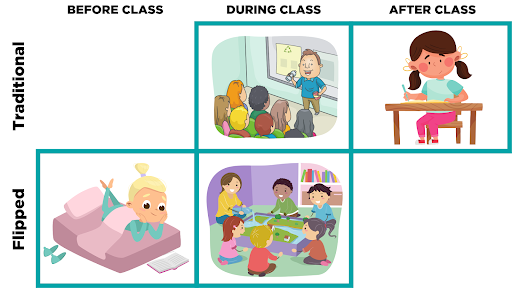Anyone who knows me knows that I am all about student engagement and creating student-centered learning. Every choice that I make in lesson planning and in course design comes down to one question: What is best for the students?
I know that there is not one single best way to teach students. Every school is different, every classroom is different, every student is different. However, I do know that there are several methods of teaching that have been proven through extensive research to be successful. My favorite method of teaching is the flipped-classroom model.
This semester is my eighth teaching CUIN 3312 Educational Technology, a class for undergraduate pre-service teachers learning how to integrate educational technology into a K12 curriculum. I teach this class using a hybrid flipped model. The course is scheduled to meet once per week for three hours, but we only meet for two. The other hour of instruction is used for the pre-class materials that make the flipped class work.
But let me back up. Maybe you’ve never heard of the flipped model, or maybe you’ve heard of it but don’t know much about it.
What Is the Flipped-Classroom Model?
Put simply, the flipped-classroom model is when you take a traditional classroom and turn it around. I’ve also heard it called the inverted classroom model, which is a fitting name. In a traditional model, class time is used for a lecture or direct instruction. Then students complete homework, which is usually some kind of practice for what they learned during class.
In a flipped model, we invert this process. Students read and watch the materials before they come to the classroom. Materials can include textbook chapters, relevant articles, curated videos, teacher-made videos, or just about anything else that provides students with the information that they need. All of these materials take the place of the lecture or direct instruction portion of a class.
So what do the students do during class? They participate in hands-on activities. The same practice activities that students would have been doing on their own as homework are now being done in the classroom where the instructor is there to support and guide students.

Benefits of the Flipped-Classroom Model
The biggest reason that I love this model is the support it builds in for students.
First, the direct instruction. When students are sitting in their neat rows of desks listening to a teacher talk, they might be taking notes, they might be doodling, they might be listening, they might be daydreaming. If they get confused, they might ask a question or they might stay silent. When the lecture materials are provided before class instead, students can read and re-read, annotate texts to help them understand, and pause or rewatch videos. They have more freedom in how they take in the information that they need.
If you incorporate options into this, you can elevate the learning even further. Provide an article and a video that both give the same information and allow students to choose. They can watch the video or read the article or both. Providing this choice empowers students to own their learning, which is one of the best benefits of the flipped model.
The built-in support for students is even more obvious when it comes to the in-class portion of the model. When students complete homework after class in a traditional classroom, there isn’t much they can do if they get stuck. Instead, the flipped classroom moves those practice activities into the classroom where the teacher is there to guide and support struggling students. The teacher is also able to swoop in and redirect students with misconceptions who may have completed an entire homework assignment incorrectly, thinking they were on the right path.
This also provides an opportunity for collaborative learning where students can collaborate with their peers to construct knowledge together, and is a great chance to implement some problem-based learning. Instead of drill-and-kill homework activities, students can engage actively with collaborative problem-solving activities.
How Do I Do It?
The trick to planning a flipped classroom is working backwards.
Start with the objectives. What do the students need to learn or do? In Texas, we have the TEKS, many states follow the Common Core. Whatever your standards are, start there.
Then plan the in-class activities. What kind of collaborative or hands-on activities do the students need? What kind of differentiation needs to be built in? In my eighth grade classes, I liked to use the in-class activities to group students by their specific needs, and often each group had a slightly different activity based on those needs.
Once you know what the students are doing in class, curate the list of before-class materials. Think about what information they need in order to complete those activities and the best way for them to gain that information.
I have a couple things to consider when putting together that list of before-class materials:
- Don’t put too much. I know sometimes we think, “If I put more things, then maybe the students will at least read half of it.” In my experience, if the list is too long, students shut down and complete none of it. Be very targeted and specific in the list.
- Like I said earlier, give students options whenever possible. If there’s a video that has the same information as an article, give them both and let them choose. Give a pre-made video on YouTube and a video of you explaining the concept yourself. Choice is always going to help.
- Sometimes we need a little accountability to make sure that students complete the list. Short auto-graded quizzes over the materials can provide that accountability and work as quick checks for understanding, but I’ve also found that simply setting the expectation early and sticking to it sends the message that the before-class materials are required and necessary.
Here’s a simple graphic organizer for planning:

I’ll be brutally honest. In my experience, it’s a lot more difficult to flip a K12 classroom than a higher education classroom, simply because college students have more initiative in their learning and often more resources and time to complete the before-class materials. That doesn’t mean that it doesn’t work in K12 classrooms. It just means that it takes careful and purposeful planning to pull off. But, boy, is it worth it in the end!
See also:



